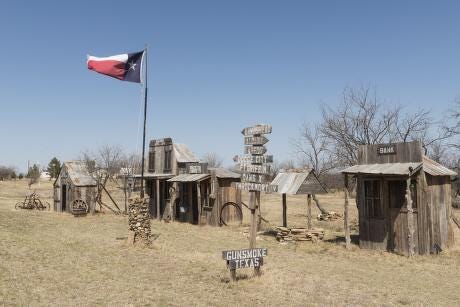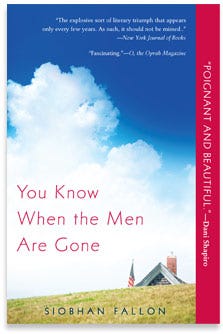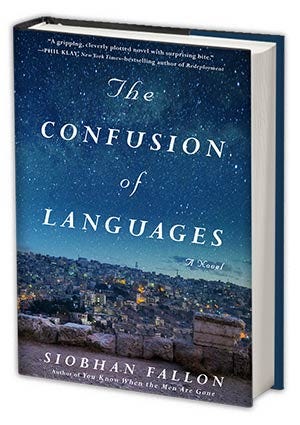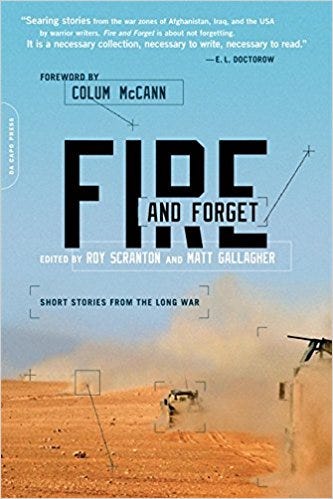The Original Outpost: The Army and the Army Family
The Literature of Army Writers and America's Sense of Self. Part VI: Siobhan Fallon
Americans love an outpost story. The Rebellion in Star Wars: A New Hope, with its outpost on Yavin 4; Westerns, both older variants such as Dodge City and newer offerings such as Yellowstone; even many popular children’s stories, such as Peter Pan, tell a version of an outpost narrative, with young people carving out a home, a tribe, and a way of life that stands in contrast to their surroundings. Outposts appeal to themes of exploration and adventure, the frontier, and self-reliance that have long been significant elements of American culture. Yet while futuristic or fantastical stories of outposts in space might captivate the imagination, the original outpost was found right here at home: the Army.
With a new nation skeptical of standing militaries and a massive frontier to defend, the Army existed primarily within small, isolated installations following the Revolution.1 This dynamic accelerated during the period of “Westward Expansion” started by President Thomas Jefferson’s Louisiana Purchase in 1803. Stretched far beyond its capacity and facing pressure to both keep American settlers safe and prevent them from starting (more) fights with Native American tribes, the Army relied on bases distributed across the nation’s borders. These outposts then, in many instances, became cities and societies in and of themselves.
Remnants of the Army frontier post of Fort Griffin (today a National Park site in Shackelford County, Texas). Source: Library of Congress.
Over the last 150 years, as the nation turned into a global superpower with a large, professional Army, the dynamic of the outpost continued. Paradoxically, even as the Army shifted to a permanent force with a smaller number of large installations designed to exist in perpetuity, military bases and military communities still exist as outposts. Surface-level connections are more abundant–soldiers and their families can live off-post in many instances, for example–but the lived experience of soldiers and their families has grown even more differentiated from their civilian counterparts in many ways. Within the military, one finds a world of structure, traditions, and hardships, a space where it is necessary to subsume the individual and family in service to the greater institution, and a community that offers forms of love, support, and connectedness with few parallels in civilian life. This stands in sharp contrast to much of American life, which has grown more individualized and atomized in recent decades.
As a consequence, Americans need guides, navigators to help them make sense of these contrasting realities and close the distance between the military and civilian worlds. In modern times, few have been so adept at this as Siobhan Fallon. A writer and storyteller, Siobhan’s first novel, You Know When the Men Are Gone, tells a series of stories about soldiers and military families at Fort Hood, Texas during the War on Terror. Published in 2012, the stories are set not in Baghdad or Kabul, but in Killeen,Texas, at the Post Exchange (PX), and in the housing shared by military families. Although war is a constant presence and three of the stories center on soldiers, in most cases the main characters are military wives. Informed by her own experience–Siobhan’s husband is a career Army officer and they were stationed at Fort Hood during the Surge years of the Iraq war–You Know When the Men Are Gone lets the reader live, so to speak, as part of a military community and see what this life is like.
Siobhan Fallon. Source: Author’s Photo.
Source: Author’s Photo.
Her second novel, The Confusion of Languages, achieves similar effect, but here we journey into life as part of an American Embassy mission. The main characters are women married to Army soldiers serving in the U.S. Embassy in Jordan. Again drawing on personal insight–she and her husband were part of an Embassy mission in the Middle East–Siobhan brings to life the parts of an Embassy that spy and war movies never show, and draws out the tensions and solidarity found within a community that exists as an outpost in a foreign land.
Source: Author’s Photo.
Her novels never diminish the differences between the Army and civilian words, but enables us to feel the resonance that exists between them. Her stories tell us that as much as a military base, or an Embassy, exists as an outpost, we can all still see part of our own story within the experiences of those on the other side of the gate.
Siobhan graciously agreed to be interviewed for Army 250. What follows is a lightly-edited version of our e-mail correspondence.
It seems like writing has always been a significant part of your life, but can you please share some of the background and context for your first book? When did you realize you wanted to write a book? And when did you know that book was going to be what eventually became You Know When the Men Are Gone?
I have always loved to read fiction, I have always loved to write fiction, so I naturally imagined writing would play a big role in my life. However, I did not expect the Army to play an even larger role!
I had just finished my Masters of Fine Arts in Creative Writing at the New School in New York City when I met my husband in 2000. We dated long-distance through his Infantry Officer Basic course and Ranger school. He was finishing his last few days of Ranger School when America was attacked on September 11, 2001. The Army experience radically changed at that moment for both the soldier and family members. He had trained for possible future conflict, and suddenly that war was now.
I began writing You Know When the Men Are Gone after my husband returned from one combat deployment (his second) and was already gearing up to deploy again. We were stationed at Fort Hood at the time, but I didn’t originally set my stories there. They originally took place at a nameless “everyman” kind of base—a mix of all of the bases we had thus far been stationed at: Fort Benning, Schofield Barracks, and Fort Hood. But Texas wanted to make itself known and slowly became an intrinsic part of the book.
I was pregnant with our first child when I started writing this collection and very aware of looming deadlines. I wanted a rough draft done before a diaper-wearing tyrant overwhelmed my life, and before my husband was sent back to Iraq. For the most part, I succeeded. But then I rewrote and reworked the stories for a couple more years, getting them right, and sending them out to literary magazines.
Your family was stationed at Fort Hood when you started working on You Know When the Men Are Gone. Did certain themes become more or less important for you as the Army went through the Surge and then subsequent drawdown in Iraq? Or did the stories you were drawn to write more or less stay fairly constant over those years?
I was writing the drafts of the stories in the time frame in which they occur—during the “surge” you mention that began in early 2007. So I was witnessing events very similar to those that unfurl in each story. My husband had deployed to Afghanistan in 2004-2005, then to Iraq for most of 2006, and Iraq again 2008-2009. I was witnessing the strain these deployments had on families as well as the soldiers. And I was also aware that civilians didn’t really have a true sense of our military world. I hoped to write something authentic enough that allowed military service members and their families to feel seen and understood, and also create a window into our world to give civilians a glimpse.
Your first book received widespread acclaim, it was placed on multiple bestseller lists and you won the Pen Center USA Literary Award in Fiction. What surprised you most about the response to your book? Are there any favorite anecdotes or stories about how the book impacted readers?
I received so many incredible emails and messages from Army spouses who thanked me for putting their experiences on the page. And I have had soldiers, especially men, including my own husband, tell me they appreciated having this insight into what spouses and family members were going through when they deployed. The overall response of the military community was tremendously supportive.
A widow once came up to me at a military spouse book club meeting and said my story, Gold Star, resonated and helped her process her own grief. And a spouse cancer-survivor approached me after attending a reading at a bookstore. She asked me if I had had breast cancer because I had written about the experience in such a way she assumed I lived it. These are two of my most powerful writer experiences—knowing I was able to connect this vividly with readers and their lives.
Of course there is the flip side of this too. One Amazon book review from a man stationed at Fort Hood accused me of trying to “make a buck” off of soldier suffering. He admitted he didn’t even read my book, and he clearly did not know I was actually a military spouse myself (obviously he also did not realize how little authors make on their books!!!), but his words (and his cruel one-star review) still haunt me. And at a reading in the Washington DC area, a woman stood up during the Q&A and accused me of airing the Army’s dirty laundry. She told me I was being disloyal to military families; she was so angry that her whole body was shaking. I can still picture her so clearly. I apologized that she felt that way. But I told her I was trying to honor our entire experience, that it didn’t help military families for the world to think our lives were easy, full of waving flags and happy reunions. Deployments are hard on so many levels, civilians should know this, and military families ought to realize that they are not alone when they struggle.
I imagine folks in the military community were heartened to read something that so accurately captures the aspects of military life less commonly featured in books, television, and movies. Has it inspired folks in the military family community to write or consider writing? I know for veterans there has been a push to support writers, and there's been a recent effort to revitalize professional writing in the ranks, but have you seen more spouses and family members writing over the past decade or so?
There is a rather vibrant military writing community. I heartily endorse the work of Professor Peter Molin, a retired Lieutenant Colonel who not only served as an infantryman in combat tours in the Middle East, but also was an professor of English at the United Stated Military Academy at West Point. He writes an outstanding blog called Time Now: Acolytes of War. This blog is a compendium of modern military fiction and non-fiction writers, poets, artists. He also reviews films about military life. He is in touch with all the military writers you know (or should know 😉 ), both service members and family members, from Phil Klay, Benjamin Busch, Matt Gallagher, Brian Turner, Andria Williams, and so many others.
And yes, I have definitely seen a push for service members and their families to write, to get involved, in workshops, book discussions, and the like.
The Wrath Bearing Tree is a literary journal that was created by a group of Veterans in 2013.
The Veterans Writing Project puts out the journal O-Dark-30, run by two writers and veterans I know, Jerri Bell and Jim Matthews.
I reached out to my friend, the outstanding author, editor, and writing-coach Andria Williams (who is also part of the military community) to see if she has any advice on this topic and she shared these insights:
“The Veterans Writing Project is an excellent and well-respected place to start out in military writing. They have several types of mentorship available - from writing groups, one-on-one-mentorship, and even a songwriting program. One of the fiction writers I worked with for an entire year sold his novel - it was very exciting. My mom cried in the hairdresser's chair when she read the end, and I bought five copies.
Don't be afraid to start up a writing group of your own - especially if you live on or near a post. The MWR often will lend rooms. But there's nothing wrong with a good old café.”
Andria is being modest by not mentioning her own https://militaryspousebookreview.wordpress.com/ which is a fantastic online site where military spouses can connect and share the various projects family members are involved with.
This is probably also a good place to mention other military creative endeavors.
I highly recommend you all watch the documentary Bravo! Common Men, Uncommon Valor, about the Siege of Khe Sanh, by husband and wife team, Ken and Betty Rodgers.
I also loved the new movie, Mending the Line, by Kelly McKendry, who is the daughter of Army officer—she and I knew each other as teenagers growing up outside of West Point. Mending the Line has a star cast (Brian Cox and Wes Studi among others) and is just amazing.
Who were and/or are writers you either had in mind or were otherwise influential on how you approached You Know When the Men Are Gone?
Honestly, part of the motivation for writing You Know When the Men Are Gone was that there didn’t seem to be other books like it out there. Tanya Biank’s nonfiction book, Army Wives: The Unwritten Code of Military Marriage, had inspired the very different television series of that name, and that came out while I was working on my stories.
I do remember a short story in the collection Refresh, Refresh by Benjamin Percy about two teenage boys whose fathers were in Iraq. Reading this was like getting hit by lightning. It galvanized me and made me realize there might be people out there who would actually want to see realistic military lives, both soldiers and families, on the page.
Your second book, The Confusion of Languages, is set in Jordan. I know you lived in Jordan and have been part of Embassy mission in the UAE as well. Did writing a book set in a foreign country—and further, one that takes its readers into the distinct culture that is an Embassy mission community—cause you to see elements of American culture differently?
Indeed! Jordan and the United Arab Emirates are very, very different places. And the embassy communities are wonderful. They felt very much like tiny, more cosmopolitan Army bases, communities within communities, if you will, set apart from the larger world outside.
The Middle East and Gulf Arab countries have so much to offer and I am grateful for our time there. My husband’s job as a Middle East Foreign Area Officer has allowed us to experience things people only dream of—wandering through the ancient city of Petra or floating in the Dead Sea in Jordan, seeing the view from the world’s tallest building in Dubai, touring gold and marble inlaid palaces and mosques in Abu Dhabi, riding camels and camping in the desert. The people we met were welcoming and kind. But I felt a constant uncertainty. I was always aware of being a foreigner and outsider. I did not speak or read Arabic, I was not a member of the Muslim faith in a place that is predominantly Muslim. I was a woman in a world that is generally governed by a strict male hierarchy, and, while our governments got along, I was always aware of an undercurrent of suspicion toward American involvement in the then-ongoing Middle East conflicts.
Like the female characters in my novel, The Confusion of Languages, there were always nuances and customs I feared I was missing or getting completely wrong.
The Army has been very good to us and I am happy about my husband’s career path. But living overseas made me promise that I would never let myself, nor my two daughters, take the freedoms of America for granted.
Last question, I know you have a great series of YouTube lessons on George Custer, Libbie Custer, and the Battle of Little Bighorn. I saw somewhere that part of your interest in this time period is in the fact that there are many similarities between the frontier Army and the issues facing America's military today. What are those similarities?
You have probably noticed some of the themes that really interest me—small American military communities and how they fit into the larger community outside of them. You Know When the Men Are Gone takes place in Fort Hood, at a time when United States Army bases were beset with issues the rest of America was not dealing with and didn’t really understand.
In The Confusion of Languages, again you have a small outpost of sorts—the US Embassy community—in the capital of Jordan. Already there is a huge cultural divide, but throw in the specter of the US presence in Iraq and Afghanistan, and then the undercurrent of the Arab Spring, and it makes for a tenuous situation for my two American female characters.
And my new work also looks at another small community—that of the Seventh Cavalry. These frontier forts, especially before there were reliable railroad lines, were isolated and cut off from the rest of America—what they referred to as “the states.”
Like our soldiers in much more modern conflicts, Lieutenant Colonel George Armstrong Custer and the Seventh Cavalry were sent to do the bidding of the United States government whether they agreed with the Grant Administration’s policies or not. For every engagement they had with the Plains tribes, the Cheyenne or the Lakota, half the newspapers would congratulate the Seventh while the other half would condemn them. They were sent on long and difficult campaigns, often lacking the manpower or supplies they needed (Congress was trying to cut down the Army then as well). And the families, themselves often in precarious positions, could do nothing but wait and hope their soldiers would return in one piece.
Additional Resources:
I highly recommend taking a look at Siobhan’s YouTube channel, where she has a great series on the Seventh Cavalry, interviews and readings related to You Know When the Men Are Gone and The Confusion of Languages.
Siobhan’s work can also be found in the book, Fire and Forget: Short Stories from the Long War, edited by Matt Gallagher and Roy Scranton.
Source: Author’s Photo.
Be Part of Army 250
If you’d like to write a newsletter post, share an educational resource about the Army, or lift up an opportunity for people to connect with the Army (e.g., an event, story, etc.), please contact Dan (dan@army250.us).
The U.S. Army shrunk considerably following the Revolutionary War. In 1789, for example, the standing Army consisted of less than 1,000 soldiers. State militias were the main source of soldiers for much of America’s early history. Our current conception of a large, professional military is very much a 20th century development.










Great piece Dan.
Thanks so much, Dan! Honored to have been a part of your series!